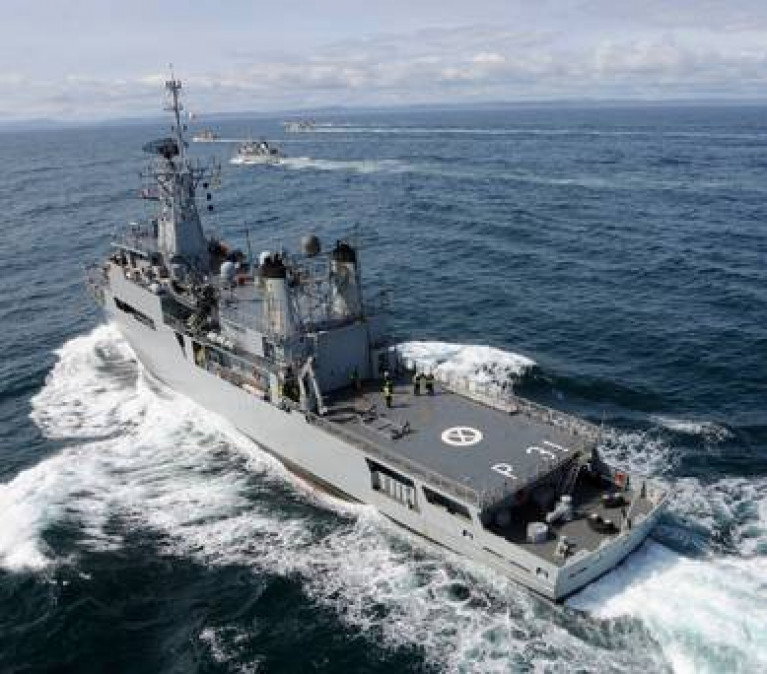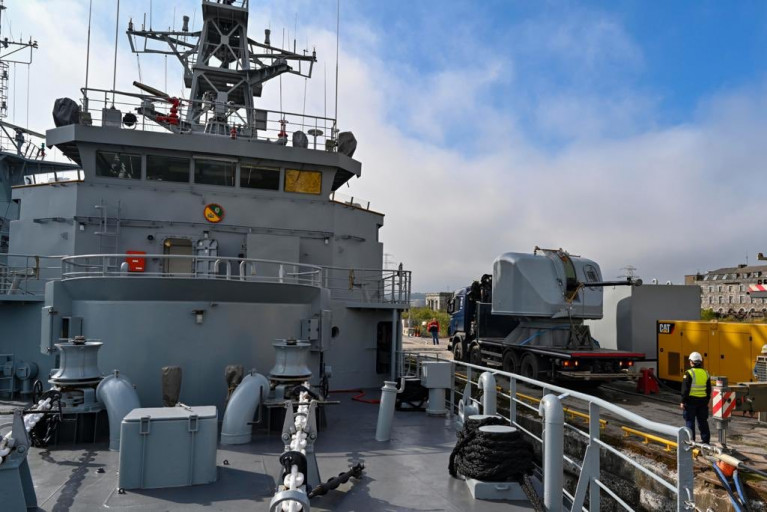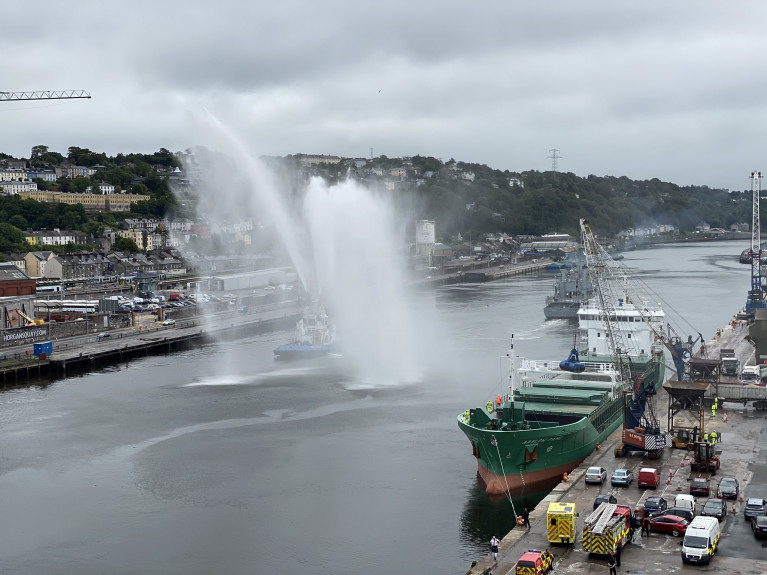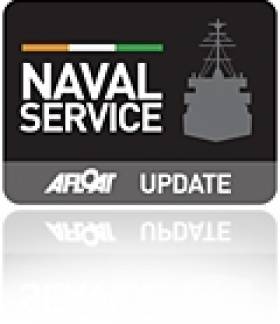Displaying items by tag: Flagship LE Eithne
Naval Service to Decommission One Third of Fleet
In a decision by the Government, a formal announcement to decommission three Naval Service vessels, which represents one-third of the fleet, is to take place in the months ahead.
The patrol vessels according to The Irish Times, are the LÉ Orla, LÉ Ciara and the Naval Service flagship LÉ Eithne, which have been tied up for several years due to the lack of sailors to crew them.
Various options are being considered by officials for the disposal of the vessels, which are between 34 and 38 years old. One option under consideration is gifting them free of charge to a friendly nation. Another is to sell them.
Both options carry potential political pitfalls. In 2015, the Naval Service offshore patrol vessel, the LÉ Aoife, was donated to the Armed Forces of Malta, despite concerns expressed by Maltese sailors about its condition. It remains in service there.
In 2016, the 42-year-old LÉ Aisling was decommissioned and sold to a Dutch company for €110,000. The company sold it on a year later for €473,000 to a company in the United Arab Emirates, which almost immediately sold it to a company in Libya for €1.3 million.
It was then transferred to one of the participants in the civil war in Libya, in breach of a UN arms embargo, where it was rearmed and renamed Al-Karama.
The Department of Defence later said it had no “trailing obligations” in relation to the vessel.
Further reporting here also includes refurbishment of ships needed
Irish Naval Service Flagship Sees Return of Refitted Main Arnament
The Irish Naval Service's oldest vessel, LÉ Eithne received its primary armament following a refit completed at the Naval Base in Cork Harbour yesterday, writes Jehan Ashmore.
The arnament is a Bofors 57mm Gun which underwent a refit carried out by personnel of the Naval Ordnance Section. Work on the Bofors took place in the maintenance hall of the Naval Dockyard facility also located at the Naval Base on Haulbowline Island.
On completion of the essential work, a truck transported the arnament on the short distance from the Naval Dockyard to the basin where LÉ Eithne was berthed.
In addition to the Bofors, the Helicopter Patrol Vessel (HPV) has secondary arnament consisting of a pair of 20mm Rheinmetall Canons and various small arms ranging from a 9mm Pistol to a 7.62mm General Purpose Machine Gun.
It was during a previous report on Afloat.ie when LÉ Eithne stood down having assisted the HSE in a support and logistical role at Cork City Quays during the Covid-19 Lock-down, that it was noted (see photo-caption) the absence of the main arnament. Otherwise the Bofors would be mounted on the fo'c'sle of the Verolme Cork Dockyard (VCD) ship completed and commissioned into the INS in 1984.
At the end of LÉ Eithne's role in Cork which took place in late June, LÉ Eithne proceeded downriver of the River Lee to the Naval Base into 'operational reserve' mode as RTE News then reported.
The HPV along with the Coastal Patrol Vessel LÉ Orla were tied-up last year due to a shortage in crew personnal that remains an ongoing issue.
LÉ Orla likewise of the flagship dates to 1984 but the CPV was built in Scotland at the Hall Russell shipyard in Aberdeen and commissioned into the UK's Royal Navy.
In Cork City along the quays the Health Service Executive paid special thanks to the Defence Forces for its support during Covid-19 at a ceremony (yesterday).
Frontline staff and members of the emergency services deployed their blue emergency lights and sirens as LÉ Eithne towed by the Port of Cork's tugboat, Gerry O'Sullivan, departed Albert Quay for its Haulbowline Naval base after 90 days of active service.
The (flagship) vessel was the last of the six naval vessels deployed under the Defence Forces' Operation Fortitude to fight Covid-19 to be stood down.
The ship's Commander Caoimhín Mac Unfraidh said he and his crew were very proud to be called upon to serve their country.
LÉ Eithne, which is 36 years old, was pulled out of operational reserve and put on active duty at Albert Quay in under 36 hours.
For more on the RTE News coverage click here and for footage as the flagship departed downriver to the Naval Base and into operational reserve.
Ageing Naval Service Flaghip LÉ Eithne to Be Replaced By MRV, Opens to Public This Saturday
#NavalService - Following the Budget, Defence spending increases to €946m next year, this will include plans to replace Naval Service flagship LÉ Eithne with a new MRV, in the meantime the ageing ship opens to the public in Dun Laoghaire Harbour this Saturday, writes Jehan Ashmore.
LÉ Eithne, a unique Irish built vessel, dating to 1984, Afloat will have more to highlight as to why and on the replacement newbuild Multi Role Vessel. The use of a MRV will enchance certain capabilities that so far have alluded the Naval Service, notably in assisting UN mandated overseas missions. In addition to the EU's Operation Sophia where the Naval Service is also tasked in the humanitarian mission in the Meditterrean Sea and where LE. James Joyce is currently deployed.
As for the opening of LÉ Eithne this Saturday, the crew will provide guided public tours to take place between 10 am – 12 pm and in the afternoon between 2 pm – 4 pm. The flagship twinned with the harbour town, will berth at St. Micheals Pier (No 4 berth). This is located behind the Harbour Plaza, next to the former ferry terminal (for Holyhead) at the end of Marine Road.
Officially, LÉ Eithne is desigated as a helicopter patrol vessel (HPV), though the use of the ship's design for French built 'Dauphine' helicopters were rarely used and took place early in the career of the 1,900 tonnes flagship. The tour will include the large aft-deck where the use of helicopters took place next to the aircraft hanger. At the bow is mounted the main arnament, a Bofors 57mm Canon.
Afloat, adds the size of the fleet at 9 ships is the largest ever in the history of the Naval Service since foundation in 1946. The naval headquarters located on Haulbowling Island in Cork Harbour, is where LÉ Eithne was scheduled for a routine self-maintenance (see related story RMS Leinster, Dun Laoghaire) This is where the State's official RMS Leinster centenary commemorative ceremony that took place earlier this month.
On the following day of the RMS Leinster ceremony, the delivery from Babcock Marine in the UK of the €67m newbuild OPV90/P60 class LÉ George Bernard Shaw took place in Cork Harbour. This OPV is included in the fleet total, though the vessel has yet to be officially named and commissioned into service.
In recent years, LÉ Eithne as alluded above was deployed to the Mediterranean Sea under Operation Sophia tasked in the rescue mission of migrant / refugees.
Such challenging and also rewarding work given the circumstance faced of the flagship crew and fleetmates so far deployed, were recognised through a Civic Honour, the 'Freedom of Entry' which was bestowed by Dun Laoghaire-Rathdown County Council on behalf of Irish citizens and the EU.
The Freedom of Entry ceremony was held last year at the aforementioned Harbour Plaza located between the harbour and DLRCoCo's Town Hall on Marine Road.
#AdoptedPorts – The ‘Freedom of Entry to the County’ bestowed to the Naval Service by Dun Laoghaire-Rathdown County Council last month took place in the harbour where flagship LE Eithne is twinned with the town. So what about the rest of fleet inquires Jehan Ashmore.
Of the current eight-strong fleet, not all of the patrol vessels are profiled on the Defence Forces website in regards to ships adopted ports as well as respective charities. The profile also gives significant events of the ship, origin of name, the commander in charge and vessel characteristics. All this can be consulted here.
Afloat contacted the Department of Defence to fill in these gaps concerning both 'updated' adopted ports and charities supported by the crew. Periodically they change to reflect crew changes and as priorities shift. The 'adoption' of a charity added the Department should be viewed as informal and is designed to give a focus to any crew fundraising initiative. It was also emphasised they should not be viewed as exclusive of other charities or causes.
Below is the completed list and should you observe any of the patrol ships making calls to their respective adopted port, consider the relationship that links crew and communities. In addition the important role they play in supporting charities and also from the public.
L.É. Eithne (P31)
Adopted Port: Dun Laoghaire
Ships Charity: Our Lady’s for Sick Children, Crumlin, Dublin
L.É. Orla (P41)
Adopted Port: Dingle
Ships Charity: Marymount Hospice
L.É. Ciara (P42)
Adopted Port Kinsale
Ships Charity: Mercy Hospital Foundation
L.É. Roisín (P51)
Adopted Port: Dublin
Ships Charity: Children's Ward Cork University Hospital
L.É. Niamh (P52)
Adopted Port: Limerick
Ships Charity: St. Munchin's neo-natal Hospital, Limerick
LÉ Samuel Beckett (P61)
Adopted Port: Cork
Ships Charity: Mercy Children's Ward
LÉ James Joyce (P62)
Adopted Port: Waterford
Ships Charity: Children's ward, Waterford Hospital
LÉ William Butler Yeats (P63)
Adopted Port: Galway
The above OPV90 class is the newest addition to the fleet, having only been commissioned into service in the ship’s adopted port of Galway in October 2016. As for a chosen charity, according to the Defence Forces this will take effect in the next few months.
'Freedom of Entry' Conferred to Naval Service As Flagship Visits Dun Laoghaire Harbour
#FreedomShip – At a special public event held in Dun Laoghaire Harbour a conferral of ‘Freedom of Entry’ was presented to crew of LÉ Eithne on behalf of the Irish Naval Service, writes Jehan Ashmore.
In the presence of ambassadors and officials among them representing the UK, Italy and China, An Cathaoirleach of Dún Laoghaire-Rathdown County Council, Councillor Cormac Devlin presented the honorary conferral to Lt Cdr. Brian Fitzgerald, commander of LÉ Eithne. Cdr Hugh Tully was also in attendance on behalf of Defence Forces Chief of Defence, Vice Admiral Mark Mellett.
Also at the lunchtime ceremony where members of the public along with local schoolchildren waving the tricolour. The proceedings included a crew party standing to attention with the backdrop of LÉ Eithne berthed behind at St. Michaels Pier. Also sharing the pier was seasonal Dublin Bay excursion boat, St. Bridget.
The ‘Honorary Freedom of Entry to the Council’ was awarded by Dun Laoghaire-Rathdown County Council to the Irish Naval Service in recognition of the humanitarian mission 'Operation Pontus' that was carried out in the Mediterranean on behalf of the people of Ireland and the EU. The conferral was the first ever presented by DLRCC and that of any council.
Master of ceremonies, RTE's Mary Kennedy hightlighted that LÉ Eithne along with fleetmates during Operation Pontus played a significant role in the rescue of 15,000 migrants and refugees. Lt Cdr. Brian Fitzgerald commented LÉ Eithne is to be deployed again to the Mediteranean in a month’s time so to resume humanitarian duties. This he added though is subject to Government approval.
The ceremony also provided an opportunity to mark a more solemn moment as a minutes silence took place to honour those lost in the Irish Coastguard Helicopter tragedy of R116 off Blacksod, Co. Mayo.
Overall command of the search remains with the Coast Guard that had involved LÉ Eithne appointed as On Scene Co-ordinator (OSC) of the operation. This role was transferred to L.É. James Joyce but this OPV has been recently relieved by class leadship L.É. Samuel Beckett in the ongoing operations at Blackrock Island Lighthouse.
On a more joyous note, at the end of proceedings in Dun Laoghaire, the Army No.1 Band led a crew parade from the Harbour Plaza. This saw the parade head up along Marine Road to outside the Town Hall of Dun Laoghaire-Rathdown.
#EmergencyExercise- Around 180 personnel from nine different agencies between them worked together at Waterford Airport and off the coast of Hook Head, to assess how well they would respond to a major disaster.
According to Declan Geoghegan, operations manager with the Irish Coast Guard, the "nightmare" scenario would be a stricken passenger ferry with about 1,000 people on board and 100 miles offshore.
For yesterday's simulation, the Naval Service's flagship LE Eithne (P31) was a 'ferry' that had sustained an explosion in its engine room, with 50 army personnel from James Stephens Barracks in Kilkenny acting as casualties. To read more on the exercise, the Irish Examiner has a report.
































































